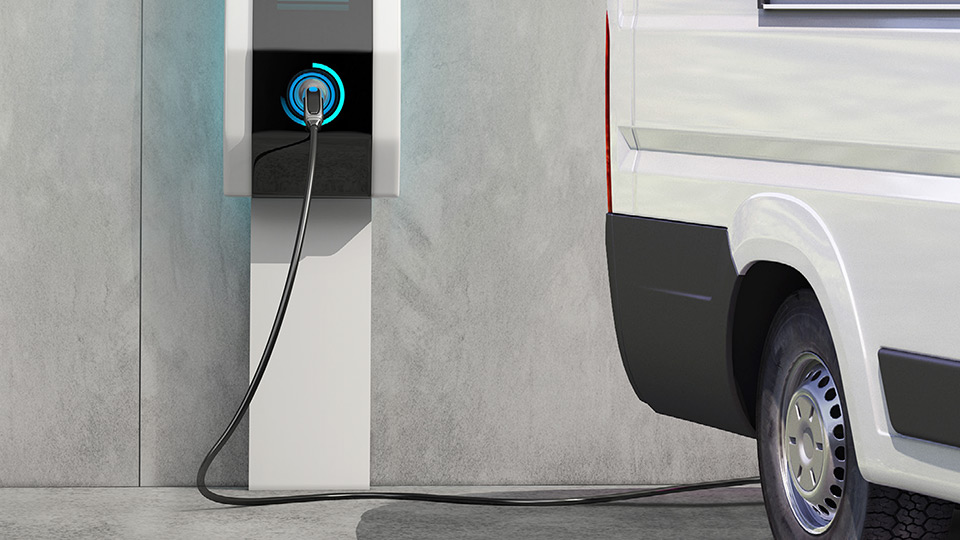
Electrifying your light commercial fleet through telematics

Table of contents
- Global electric vehicle adoption
- EV trends in Europe
- The barriers to EV adoption are disappearing
- More fleets have begun adopting EVs
- Going electric begins with an EV Suitability Assessment (EVSA)
- Unlocking your fleet's potential through a connected platform
- Optimising the EVs in your fleet
- Conclusion
- About Geotab
Global electric vehicle adoption
Although electric vehicle (EV) adoption has been slowly rising over the last decade, it has now entered a stage of exponential growth. Governments and progressive companies from around the world are focusing on sustainability, with an emphasis on the transportation industry.
Up until recently, the majority of commercially available EVs have been consumer passenger vehicles. However, with the increased interest, there has been a wave of technological advancements, particularly in regard to batteries. These improvements have made it viable to create electric commercial fleet vehicles, and vehicle manufacturers are now committed to providing electric options.
Electrification is becoming an increasingly important task for any fleet, and it will be critical for future success. This is not only a result of them becoming a requirement by governmental mandates, but electric vehicles have a lower operating cost and have the potential to generate a lower total cost of ownership (TCO) even without incentives like rebates or tax savings factored in. If a fleet wants to remain economically competitive, they will need to begin incorporating EVs.
EV trends in Europe
The growing trend of EV adoption can best be seen by looking at vehicle sales during the COVID-19 pandemic. In 2020, overall vehicle sales in Europe fell by 22% but new EV registrations more than doubled to represent 10% of total sales. In 2020 electric Vans account for less than 2% of total registrations at just 5204. In 2021 we have seen this grow to almost 3% and expect the market to go beyond 10,000 electric van registrations for the first time.
At time of writing(YTD Oct) 2021

There were many regulations and initiatives that led to this increase in EV sales. 2020 was the year that Regulation (EU) 2019/631 went into effect; a bill that set CO2 emission performance standards for new passenger cars and vans. However, it was not just a matter of regulations. Many European countries including the UK created incentive programmes for purchasing EVs in an effort to help stimulate the economy during the COVID-19 pandemic.
While the light commercial vehicle sector is currently trailing behind in regard to adoption, this trend is going to change. They represent significant growth potential for original equipment manufacturers (OEMs) and a potentially significant operational benefit for fleet managers. And of course, EVs provide the most significant solution for reducing Green House Gases (GHG) and improve local air quality in the transportation sector. All pushing to achieve a net zero carbon economy in the EU by 2050.
With the pending ban on the sale of new internal combustion engine (ICE) vehicles, and the increasing number of formal Clean Air Zones (CAZ), the transition to electric vehicles has never been more important.
Who leads the electric mobility charge?

The barriers to EV adoption are disappearing
The road to electrification has had its fair share of roadblocks, making it difficult for companies to start the process. Fortunately, many of these issues have been addressed, making it easier for fleets to take smaller steps to incorporate EVs.
Range limitations and range anxiety are less of an issue
The most common challenge, which affected both consumer and commercial drivers, was the limited distance or range an EV could drive between charges. This not only led to range anxiety, the fear of running out of a charge before reaching their destination, but it also limited their effectiveness in high-use scenarios.
This issue has reduced for many of the use cases, as ranges have increased significantly in the past 18 months, as battery technology has improved. Whilst WLTP numbers should only ever be a guide, vans with more than 200 miles (official range) are now more readily available. One example is Vauxhall’s Vivaro-e with a range of 205 miles with its largest battery.
*Driving styles, outside temperature and topography all affect range. Going forward, range will only continue to increase since OEMs understand that it is a crucial selling point for any vehicle.
Improvements with charging infrastructure and capabilities
Another area that has seen significant improvements over recent years is charging availability, and fleets with long-distance needs can take advantage of the growing public charging network. Developing more charging infrastructure is still seen as a priority. As a part of the European Green Deal, which aims to reduce greenhouse gas emissions from transport by 90% by 2050 compared with 1990, the EU has set a target of having one million public charging points available by 2025.
Carrying capacity
Historically, the majority of EVs available on the market were compact to mid-sized passenger vehicles, meaning they were not suitable for many commercial fleets. Fortunately, there has been an increase of new, more capable commercial models on the horizon.
As the technology continues to evolve, there will soon be more suitable EV’s to meet commercial fleet needs. This includes payloads with no compromise, and a wider array of use cases including conversions such as lutons, tippers and drop-sides.
More fleets have begun adopting EVs
Proof that the barriers to EV adoption are being addressed can be seen in some of the largest commercial fleets' embrace of EVs. Over the last few years, last-mile delivery fleets, including DHL, UPS and FedEx, have all made commitments to fully electrify over the coming years. Meanwhile, Amazon made headlines in 2019 when they ordered 100,000 fully electric delivery vans from Rivian, which are already on trial in selected regions in the United States, and also have 1,800 EVs from Mercedes-Benz Vans in operation for its delivery fleet across Europe.
Commercial electrification is by no means limited to last-mile delivery as we have seen an increase of vehicles in other industries.
Examples of industries incorporating EVs:
- Facilities management
- Government & Public Sector
- Temperature controlled solutions
- Field service engineering
Going electric begins with an EV Suitability Assessment (EVSA)
Whatever you do, your vehicle must be fit for purpose. In order to make the transition to electric vehicles as seamless as possible, Geotab offers a free EV Suitability Assessment tool that provides data-driven recommendations. The tool analyses your fleet's driving profiles and patterns to identify which vehicles are best suited for EV replacement. An EVSA creates a blueprint for electrification that outlines the financial and environmental impacts of incorporating EVs.
Finding the right EV for the job
The first thing that needs to be considered before replacing an internal combustion engine (ICE) vehicle with an EV is range. For an EV to be a viable replacement, it needs to be able to handle the daily driving distances of its predecessor on a single charge.
The EVSA reviews each fleet vehicle's data and calculates the longest daily driving distance recorded. It will then verify that the EV can meet this demand, even under extreme weather conditions, which can reduce the vehicle's effective range.
Reviewing the total cost of ownership (TCO)
Once it has been confirmed that there are EVs that meet the performance requirements, the EVSA determines which ones are cost-effective. Typically, EVs have a higher upfront cost than an equivalent ICE vehicle, but they have a much lower operating cost.
The EVSA calculates replacing the selected vehicle with an EV and an equivalent non-EV. To ensure that it is a fair comparison, the financial analysis incorporates fuel/electricity prices, maintenance, acquisition costs and other factors to provide an accurate overall lifetime cost of the vehicles, including incentives. If the lifetime cost of the EV is lower, it is deemed a viable replacement.
Quantifying the environmental impact
Sustainability is becoming more crucial than ever and EVs provide an opportunity for fleets to significantly alter the impact they have on the environment. To highlight the impact of going electric, the EVSA will calculate tailpipe emissions reduction and the amount of fossil fuel saved over the lifespan of the vehicle.
Geotab offers additional tools to help you out in your electrification journey.
Temperature Tool for EV Range - Learn how hot and cold temperatures affect your EV's range.
Unlocking your fleet's potential through a connected platform
For any business to be successful, they need a complete understanding of their day-to-day operations. The ability to gather and analyse real-world data is a critical component for maintaining a profitable and sustainable fleet.
The Geotab connected vehicle solution pulls the data from all connected assets and centralises them onto an award-winning fleet management and tracking platform. This scalable platform offers a solution for fleets of any size and vehicle mix.
Optimising the EVs in your fleet
Adding EVs is only the first step to creating a more sustainable fleet. Monitoring the performance of vehicles is important to maintain an efficient and profitable fleet. Tracking trends in utilisation, downtime and driver safety all contribute to a smoother operation, and they apply to any vehicle in your fleet.
EV-specific techniques to consider:
- Reviewing charging logs to ensure that all EVs are being properly charged
- Evaluating an EV's state-of-charge (SOC) when determining if it could be dispatched for a task
- Monitoring fuel consumption to identify that plug-in hybrid electric vehicles (PHEVs) are not solely running on petrol
Conclusion
We are living in an age of significant technological growth, which is affecting every aspect of our lives. While this rapidly changing landscape poses challenges for fleets in their day-to-day operations, it also represents enormous opportunities.
By embracing newer technologies, like connected vehicles, a fleet can streamline and optimise their business in order to become more profitable. Incorporating electric vehicles into the mix also provides an opportunity to become more sustainable, and realise significant operational benefits.
To learn how you can electrify your fleet with confidence, visit geotab.com/uk/evsa.
About Geotab
Geotab is advancing security, connecting commercial vehicles to the Internet and providing web-based analytics to help customers better manage their fleets. Geotab's open platform and Marketplace, offering hundreds of third-party solution options, allows both small and large businesses to automate operations by integrating vehicle data with their other data assets. As an IoT hub, the in-vehicle device provides additional functionality through IOX Add-Ons. Processing billions of data points a day, Geotab leverages data analytics and machine learning to help customers improve productivity, optimise fleets through the reduction of fuel consumption, enhance driver safety and achieve strong compliance to regulatory changes. Geotab's products are represented and sold worldwide through Authorised Geotab Resellers.
To learn more, please visit www.geotab.com/uk and follow us @GEOTAB and on LinkedIn.
About Geotab
Geotab is a global leader in connected vehicle and asset solutions, empowering fleet efficiency and management. We leverage advanced data analytics and AI to transform fleet performance, safety, and sustainability, reducing cost and driving efficiency. Backed by top data scientists and engineers, we serve over 55,000 global customers, processing 80 billion data points daily from more than 4.7 million vehicle subscriptions. Geotab is trusted by Fortune 500 organisations, mid-sized fleets, and the largest public sector fleets in the world, including the US Federal Government. Committed to data security and privacy, we hold FIPS 140-3 and FedRAMP authorisations. Our open platform, ecosystem of outstanding partners, and Marketplace deliver hundreds of fleet-ready third-party solutions. This year, we're celebrating 25 years of innovation. Learn more at www.geotab.com/uk, and follow us on LinkedIn or visit our blog.
© 2025 Geotab Inc.All Rights Reserved.
This white paper is intended to provide information and encourage discussion on topics of interest to the telematics community. Geotab is not providing technical, professional or legal advice through this white paper. While every effort has been made to ensure that the information in this white paper is timely and accurate, errors and omissions may occur, and the information presented here may become out-of-date with the passage of time.
Recent News

The Unseen Toll: Driver Stress and Road Safety
May 13, 2025


In the Driver’s Seat: Accelerating ROI Through Trusted Data Insights
July 12, 2024

